|
The last couple of days were quite tough. Only three more days to go before Leaving for the LondonEdge trade show. And because things don't always go as planned a lot comes down to the last minute. Including receiving my sales samples.. Besides the delay we had because the transport of the fabrics (note to self: this will not happen again) we had delay because of the care labels. How much I am pro EU, the 20 pages rules and regulations for care labels appears to be a bit much. It didn't stop me to go over them and compose my labels as they should: In three European languages, with all the fabrics in the official terms, and of course the laundry symbols. And my personal add, a written explanation. Who reads an knows the care labels right?? As it turned out, and don't ask why, the text caused another delay of a few days, meaning my samples were ready for shipping Tuesday at 11. And that leaves me one or two days to get them here from Romania, one day to inspect, photograph, put them on my website and a lot of praying nothing goes wrong with the transport.. (note to self no2: send care label instructions sooner) As it turned out the package will be delivered today. So I can start breathing again. Well, a bit. There is still a bit of uncertainty of how it all turned out. Despite all the communications.
The process in short: I send my sample I made as an example of what it should look like. I send a detailed description per item with everything in it regarding pattern matching, button placement, seam allowance every detail you can think of. Then they make for me the first samples. They were send to me, I look over them and we communicate adjustments. Modern communications such as Skype make it quite easy to make quick decisions with pictures or video calls. Today is about having faith. With everything you do for the first time in your life, it is normal to encounter difficulties. It's important not to be afraid of the hurdles, and just simply start taking them.
2 Comments
It has been a long time since I posted something. Because I have been busy. So busy in fact that the last year I noticed I had to let possible orders go because I was making trousers. And more trousers. And then some more.. So after making my 50th pair I was sure some things had to change. Besides I was working for next to nothing giving the hours that go into one pair (yes, I am picky on the details) So for months I have been walking around with the idea of heaving them made for me. The next couple of posts will be about my journey towards running a lable instead of a single sewing machine. It will give you insight about what happens before a garment is in a shop. I will write when it is successful and when it’s not. Sometimes it will take courage to share the failures. And now at this moment I can’t really tell which way this will go.. I have hope, and a dream, and my goal is to achieve these.
Where to start? Obviously I had to find somebody to help me with starting. Somebody who knows the industry and can help me with the how to’s. I found that person soon and the next obvious step is making business models, lots of counting and numbers and other stuff I never wanted to know about. So I got myself through that. Had a small fund to start, mostly saved from the 50 trousers I had made so far. My coach found me a small factory in Romania that would be suitable for my products and is willing to produce small amounts. So gar so good.. But this is just the start.. I made all the patterns, sent them my samples and things got rolling. It got ‘exciting ‘ when life got in the way. Because that is what life does. Since September last year I had more and more trouble walking. I always had some pain for the last 15/20 years, sometimes bad, sometimes none. No doctor really could find what was wrong for years. Now it got so bad something had to be done, and in December I had hip replacement surgery. Not something you’d expect at 44. Apparently something had been wrong with that hip since I was a child, so that explains. Not convenient when you are in the middle of an adventure! Somehow I managed to get things started in Romania with the first sample pieces before my surgery. Have been sourcing materials, so I was ready for it! What I didn’t expect is I was how weak and dizzy I was afterwards. For weeks! Living in a mist, not being able to think was probably the worst. (Though some people received two or three Christmas cards last year 😂) Finaly in January I could decide to book a stand on LondonEdge in February. The one and only lifestyle trade show in Europe. So the deadline was set. I needed my sales samples in time for the show. We made a time table with the factory and decided when and how to ship the fabrics. So there we were. In Amsterdam at a small shipping company that drives to Romania twice a week. With thousends of Euro’s worth of fabric, packed and wrapped in separate packages. The guy responsible for taking in the packages mumbled something.. “problem.. zwanzich.. twenty.. mumble.. problem..” As it turned out when his English speaking wife came down, the individual packages couldn’t weigh more twenty kilograms for the shipping on Saturday they were supposed to be on.. OK.. now what. “Can I get them back and repack them?” I could go to a DIY shop, get plastic and make smaller packages. “No, problem.. “ He had already made the shipping lables for transport on Thursday so he couldn’t give them back. I tried everything. Standing on my head, do a dance, sing a song, nothing helped. The fabrics would arrive at the factory a week later than planned, which meant they couldn’t start production in time!! Nothing I could do could change the situation. Only except it and hope for the best. Light an extra candle, hope and try not to think about all the things that can go wrong is the best strategy in that situation.. So fingers crossed.. The stand is booked, money has been spent, no turning back. Just hope. (And take calming drops to be able to sleep) Vintage style menswear, it can be so much fun! I am full of ideas and thoughts and with every piece I make, I create a new idea in the same time. So this keeps me going. When I started this I never thought that creating menswear can be as much fun as ladies wear. Today is a quiet day after our photo shoot yesterday. I have to clean my studio which is rather messy after working on the fall/winter collection and preparing for the shoot. So it gives me time to stop and think about what I have been making, look back and contemplate. The first pair of trousers I have made were kind of conservative. I was searching for the original 1930's shape, and looking for typical vintage features and re-create them. Now I like to go for more daring fabrics, and be bolder in combining colors and fabrics. Along the way I noticed that there are men who have fun with their vintage style wardrobe, who dare to combine. Maybe the whole barbershop trend is helping that as well. Men grooming their beard, conscious of their appearance, taking care of their wardrobe and finding their own personal style is rather a new thing maybe, but for me has is highly associated with 19th century England. With the Victorian Gentleman who was well dressed and eloquent, elegant in clothes and manner. Oscar Wilde could have been called a dandy, and George Brummel (1778-1840) must have been the King of dandies. In the essay "Du dandyisme et de G. Brummell" french writer Jules Barbey d'Aurevilly (1808-1889) looks at Dandyism as a cultural-historical phenomenon. The dandy is self-assured, confident, completely independent, and revolting against mediocrity and uniformity. I think I rather like that kind of fellow! A common mistake is that a Dandy is confused with a snob, however a very distinctive characteristic is his way to relativize himself. There were female Dandy's as well. I believe Marlene Dietrich could be called a female Dandy. To synthesize: a Dandy has his own style and is not bothered with conformation. I can only proclaim that we all find the Dandy within. Please don't think about what fashion magazines dictate. In the vintage world of dancing and clothes, some people tend to go over the top I think. Not in what they themselves choose to wear, but in judging others. Should you really care if your hair is or isn't exactly 1940's or 1950's? Should you be bothered where you find your ideas? Internet, fashion mags, the haut couture or the street? Find your own style and be yourself! Why not mix old and new, punk and vintage, rockabilly and steampunk? Lets all start thinking outside the box, and please do not color between the lines. This is what makes people interesting!
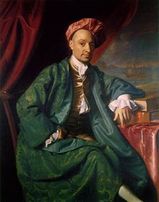 Ward Nicolas Boylston, a wealthy merchant, in a Banian. Ward Nicolas Boylston, a wealthy merchant, in a Banian. In the beginning of the 17th century, lots of goods from the new world was imported in Europe: spices, coffee, tobacco and silks. It became very fashionable to be depicted in a 'robe du chambre' or banian. It is from these garments the smoking jacket evolved. In the second half of the 19th century smoking became very popular in England, and a gentleman would retreit after dinner to the smoking room and the smoking jacket intended to absorb the smell of smoke and protect the gentleman's clothes from falling ashes. A smoking cap might have been worn with it. The smoking jacket kept its popularity well into the 20th century. Gary Grant, Fred Astaire and Dean Martin being enthusiastic wearers of this type of jacket. Sherlock Holmes must be the most famous of the smoking jacket fanatics. Probably the pipe has something to do with it. All this makes me think of a time in history... I was young, the days were endless, we all would live forever and we smoked..
Today the Plus four is most commonly known as a golfers outfit. And since the Plus four was worn often during sports and outdoors, we now can understand why golfers love to adorn themselves with puffed trousers and checkered socks.
read more:
Jocks and Nerds, Men's style in the Twentieth Century, Richard Martin and Harold Koda
The waistcoat is said to derive from the Persians in the 17th century as seen by English visitors to the court of Shah Abbas. King Charles the II got the credits for introducing it in the European style of clothing. After the Great Plague, and the Great Fire of London, he felt the need for a more sober style of clothing. It was designed to discourage the use of lavish materials, and cover the body much plainer and cheaper than before. John Evelyn wrote about it on October 18, 1666: "To Court, it being the first time his Majesty put himself solemnly into the Eastern fashion of vest changing doublet, stiff collar, bands and cloak, into a comely dress after the Persian mode, with girdles or straps, and shoestrings and garters into buckles...resolving never to alter it, and to leave the French mode".
Read and see more: I Am Dandy: The Return of the Elegant Gentleman by Nathaniel Adams History of men's fashion, Nicholas Storey After all that writing about suits and menswear, let's have some girl talk again about dresses. Spring is definitely coming, and it is time to put away the woolen sweaters, long trousers and socks and get your skirts and dresses out! So what to wear when you are a vintage gal?
While I was writing about fashion the second world war in my blog last week, I came across a topic I would like to write little more about: the zoot suit. Many know of the zoot suit through Cab Calloway, who was known for it, and had many varieties. Personally I love the one he was wearing in ‘Stormy Weather’ , the wonderful film with Lena Horn, Bill Robinson (mr Bojangles), the Cotton Club orchestra, Fats Waller, and of course Cab Calloway. A must see if you haven’t already. 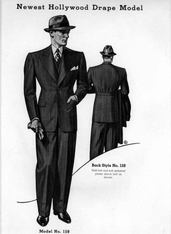 What is a zoot suit, and how did this fashion take of? In the thirties high waisted pants, so called slacks, were in fashion. The silhouette was masculine, broad shouldered and narrow waisted. The ‘English drape’ grew popular. London tailor Scholte designed a suit with jackets with wide shoulders and chest, wide armholes and narrow waist, worn with high waisted tapered pants. This look conquered America in the midst of the Great Depression. Hollywood embraced this drape cut. Men Like Gary Grant and Clark Gable wore draped suits. By 1940 the drape style became known as the ‘American cut’. As the Great depression deepened, men started mixing jackets and pants. Menswear changed. Sportswear was common, and especially in World War II men changed their factory overalls for simple T-shirts and slacks instead of suits. The men’s garment industry started manufacturing for young men. Style that adults would never wear. Film and dance also influenced fashion. The Sears catalogue of 1941 offered new wide legged pants called ‘swing pants’ and colors ranging from brown to teal blue and medium green. The drape suit started to evolve. In Harlem there were tailors advertising with ‘extreme English drapes’. Other clothing stores advertised with ’New long drapes’ and adds for pegged pants or ’Jitterbug pants’ started to appear. Photographs of the Savoy ballroom in Harlem show these extreme drape style. In Chicago tailor and trumpeter Harold Fox gained clients with musicians and performers. In his store many jazz musicians gathered because of his costumes and the music was good too. According to Fox the zoot suit was not his invention: It came ‘out of the ghetto’. Young men walked in at tailors and asked for them to make wider and longer jackets, and pegged pants.
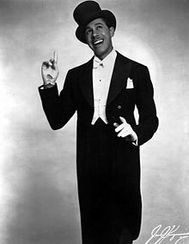 Cab Calloway spread his ‘Jive talk’ and zoot style to musicians in the black community, and also with his white patrons. Soon zoot suits were even worn at the ‘White only’ venues. The name ‘zoot’ could well be deriving from his “Hipsters Dictionary of Jivetalk’ meaning ‘the ultimate’ or ‘exaggerated’. By the early 1940’s the zoot suits became popular with the Mexican youth. In 1943 there were the infamous ‘zoot suit riots’. In Los Angeles, more and more Mexicans took refuge. Together with the war that took away many white men, the jazz scene that openly defied segregation, this caused a lot of racial tension. In 1942 after ‘the sleepy lagoon murder trial’ involving mostly Mexican American men, zoot suited or not, the suit was associated with gangsters and rebels. These riots could well have been called ‘sailor riots’. As they were started by sailors and soldiers who spotted a group of Mexican American women across the street. As they were approaching them, they found a group of zoot suiters in between them. Sailor Coleman claimed he thought he was being attacked, and grabbed the arm of a zoot suited man. Coleman was hit on the head, and from that incident on sailors organised strikes on zoot suiters. The violence continued multiple nights and affected everybody even remotely associated with zoot suits, Mexican youth and jazz. The Los Angeles city counsel approved of criminalising wearing zoot suits with reat pleats. The worst violence was at June the 7th 1943. A Los Angeles paper printed a guide of how to ‘de-zoot’ a zoot suit: “Grab a looter. Take off his pants and frock coat and tear them up and burn them.” That night 500 civilians, sailors, marines and soldiers gathered downtown to go after the Mexicans and African Americas. That year a committee ordered by the governor determined racism to be a central cause of the riots. The Mayor however concluded that juvenile delinquents were the cause, and racial prejudice had nothing to do with it. 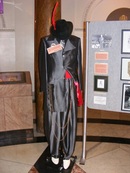 So… It was ‘just’ a youth style from the streets. And maybe one of the first to occur in the history of fashion. Others would follow, and certainly nowadays we are used to the idea that street styles first appear in Harlem. Like the jeans that were put on backward, the very low worn pants, cap styles, the zoot suit was merely a street style loved, worn and made famous by dancers and musicians. The zoot suit riots had nothing to do with the suits and were based on racism rather than clothing style. Feel free to wear one, you should only be associated with dancers and musicians. In my mind that is not bad at all! Read more: Zoot suit, The enigmatic Career of an Extreme Style, Kathy Peiss American Experience http://www.pbs.org/wgbh/americanexperience/ Cab Calloway, Hepsters Dictionary For this once, I had to put in two video's.
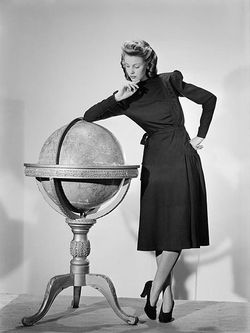 -dress may only have 2 pockets -No metal or leather buttons -No boys under 13 could wear long trousers -All embroidery and lace were banned -Jackets and coats could hove only 3 pockets -No double breasted Jackets and coats -Trousers could not be cuffed -No shirring, rushing, boning or fancy stitching was allowed a 1940's 'Utility dress'
So considering that all, you might want to respect the 1940's women for keeping a sense of style and grace under these conditions. And it made the way for later generations to start wearing more practical clothing. Everything was influenced by the war. Not in the least music was. To keep up moral for the men at the front. This song by Gene Krupa and Anita O'Day is a fine example. I have been making a small study out of the 1930's and 1940's men's slacks. I wanted to make them, and so I needed to spend time in books, on internet and inside my head to figure out just the right design. What did they wear? Men's fashion went through a bit of a transformation after the first world war. Life changed, and so fashion changed. The men's pants grew in width. And as always, young people lead the way. The widest pants were the Oxford Bags, worn by Oxford students when they wanted to hide their knickers, since they were forbidden from 1925 onwards. They were mostly worn by the undergraduates. Another novelty was the introduction of the zipper in the trouser fly. The prince of Wales was the first to wear it, and it soon became very popular. Overall, the male figure was supposed to be masculine and sportive: narrow waisted and broad shouldered. The pants were high waisted, 2 or 3 inches above the navel, and tapered. The jackets grew wider at the top, shoulders were padded and the lapels of suit jackets were wide across the chest. This was called the English drape suit, or lounge style. This became very popular in the United States, as this add shows: A small detail I discovered while making the pants, concerns the pleats in the front. Modern pleated trousers have the pleat folded to the outside. Some vintage patterns I own clearly indicate the pleats should fold inwards. And yes, looking at drawings and pictures, both were used. I chose to fold them inwards to create a more convex shape. And this is what they look like. My model was clearly in a hurry, but oké, a musician isn't necessarily a gentleman. 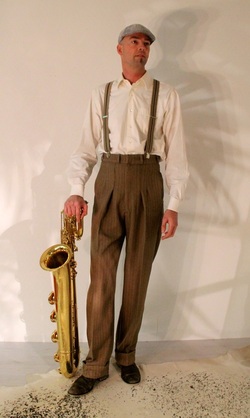 View details of pants The Oxford Bag had a revival in the eighties, so obviously, this song comes to mind: |
Sunny van Zijst
I am maker of vintage inspired couture. I was trained as a designer for theater costumes. Now I enjoy making vintage inspired clothing for men and women. Archives
July 2023
|
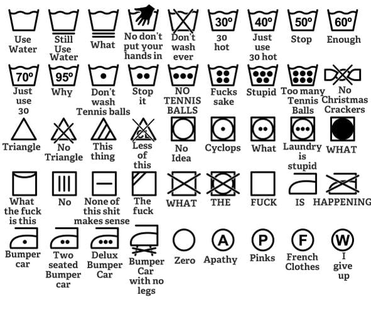
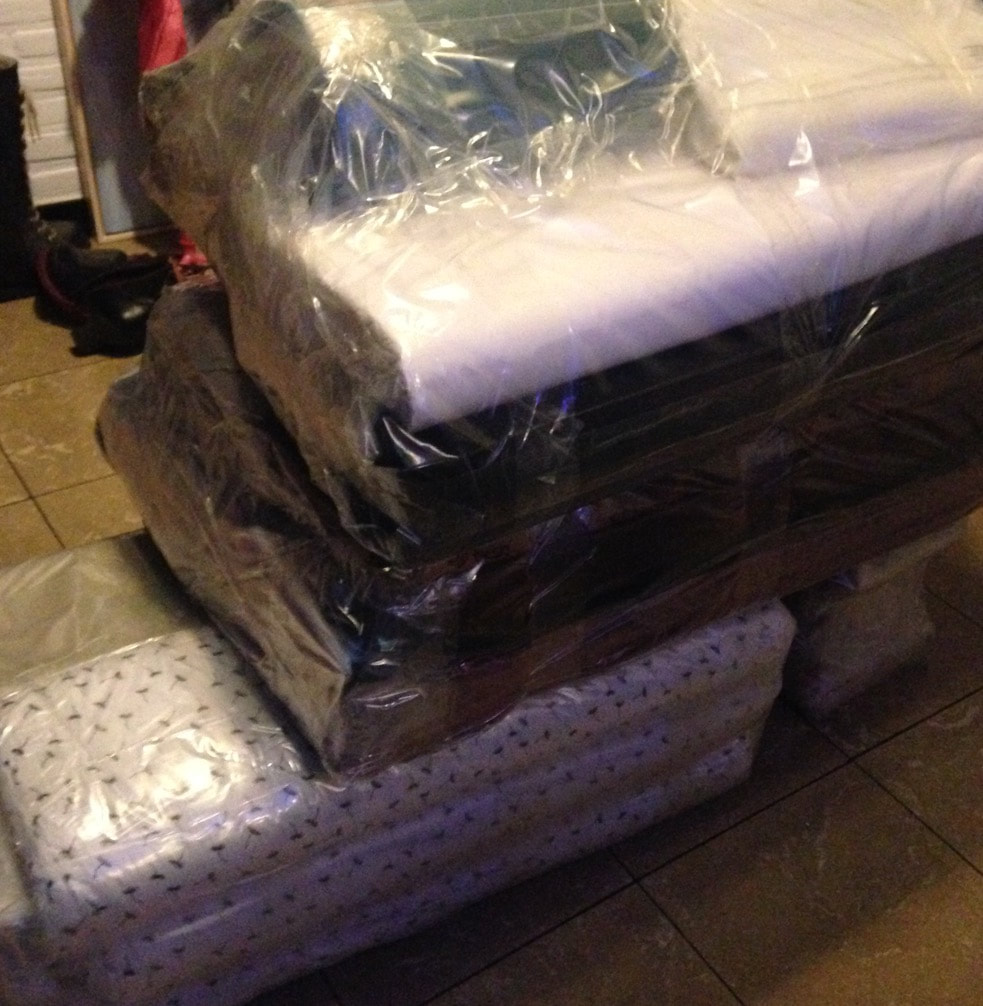
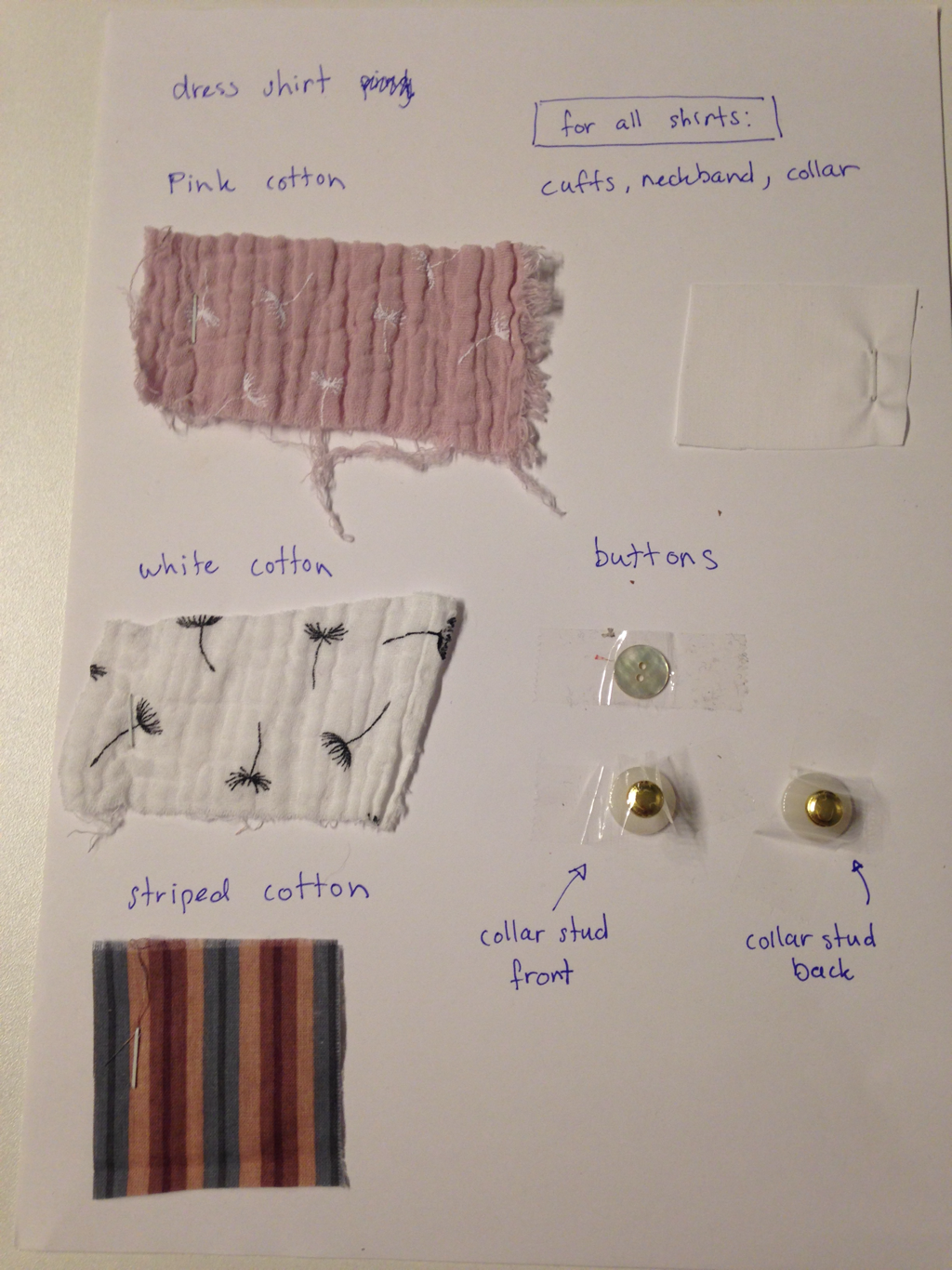
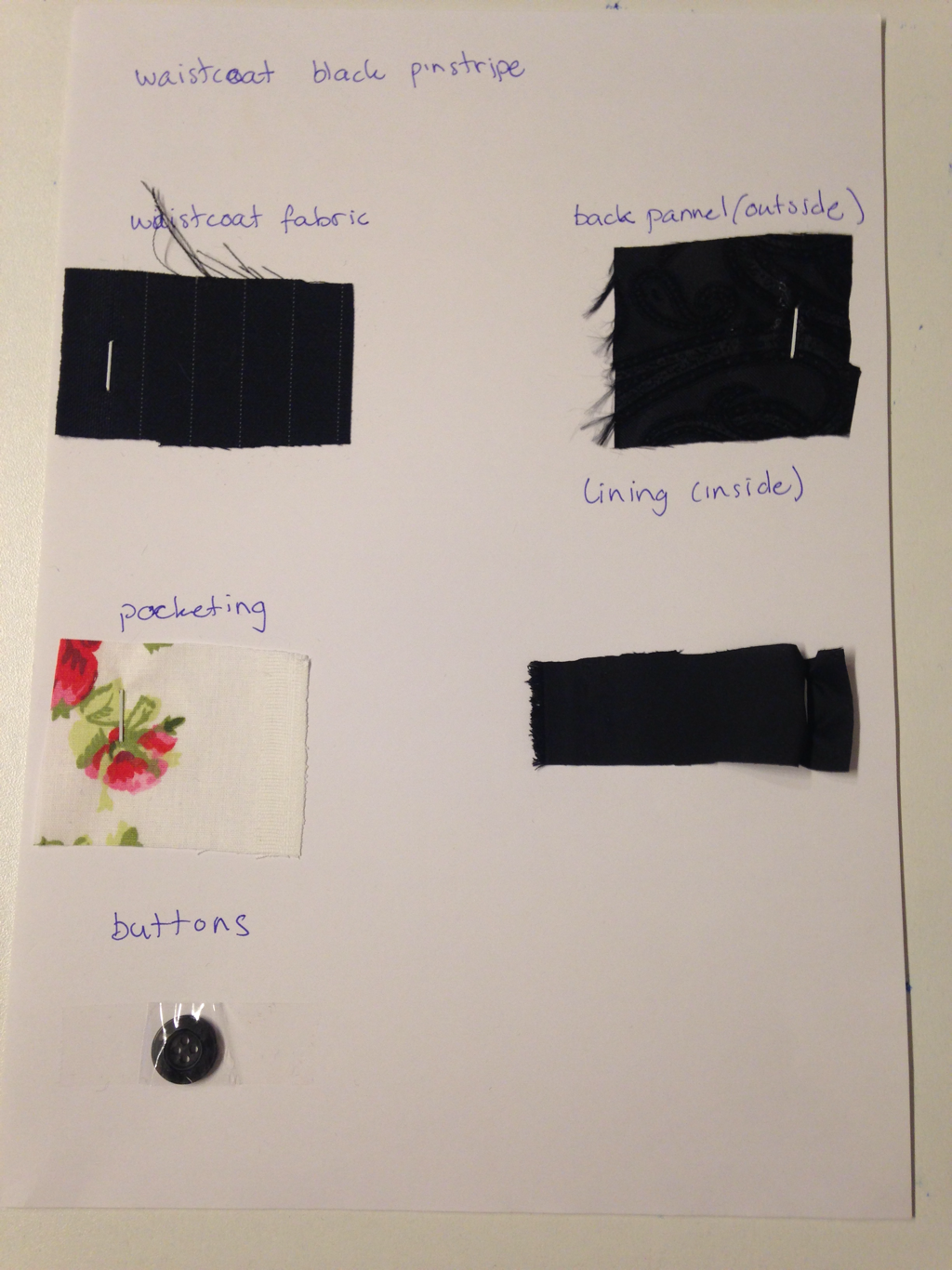
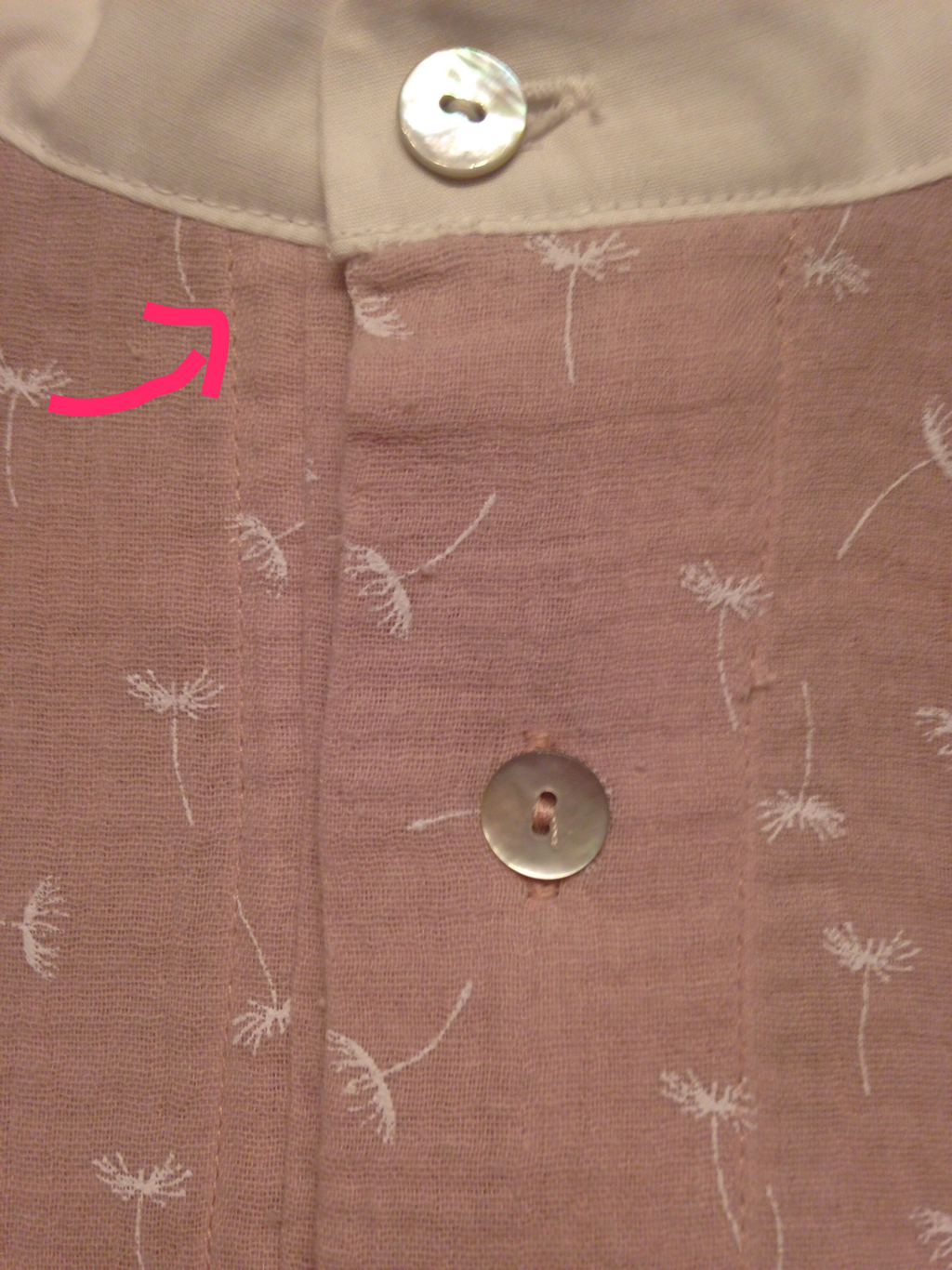
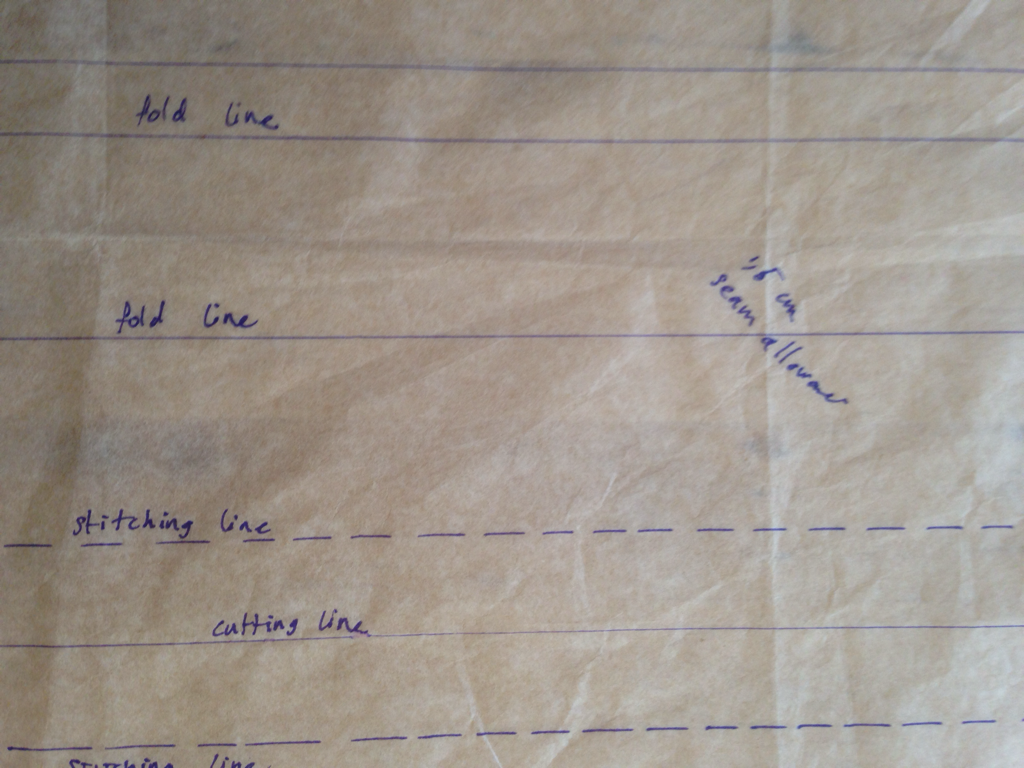

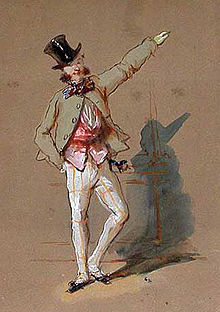

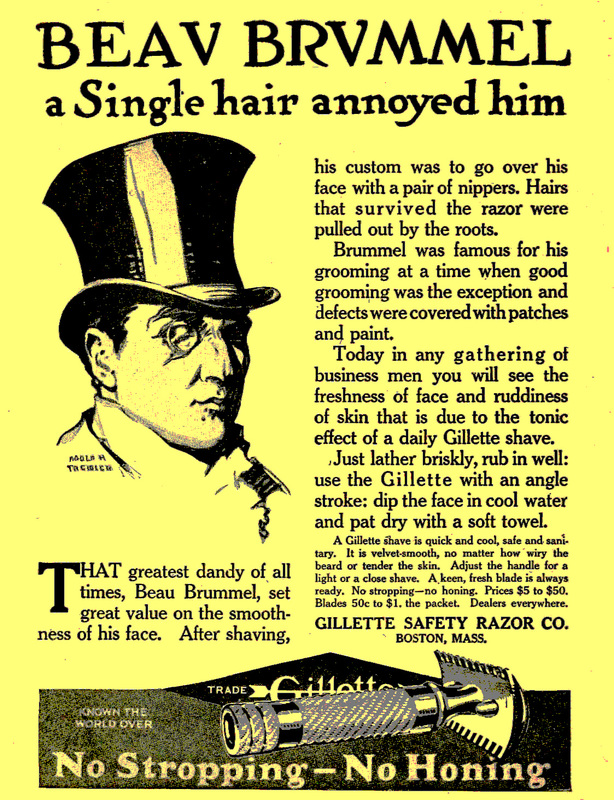
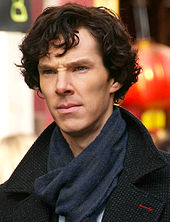
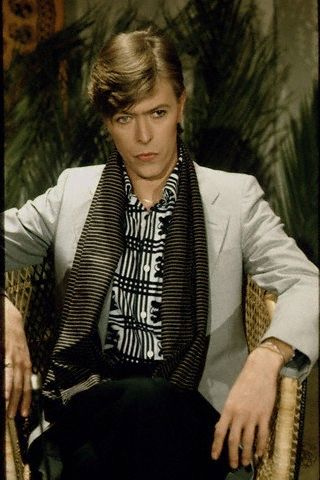
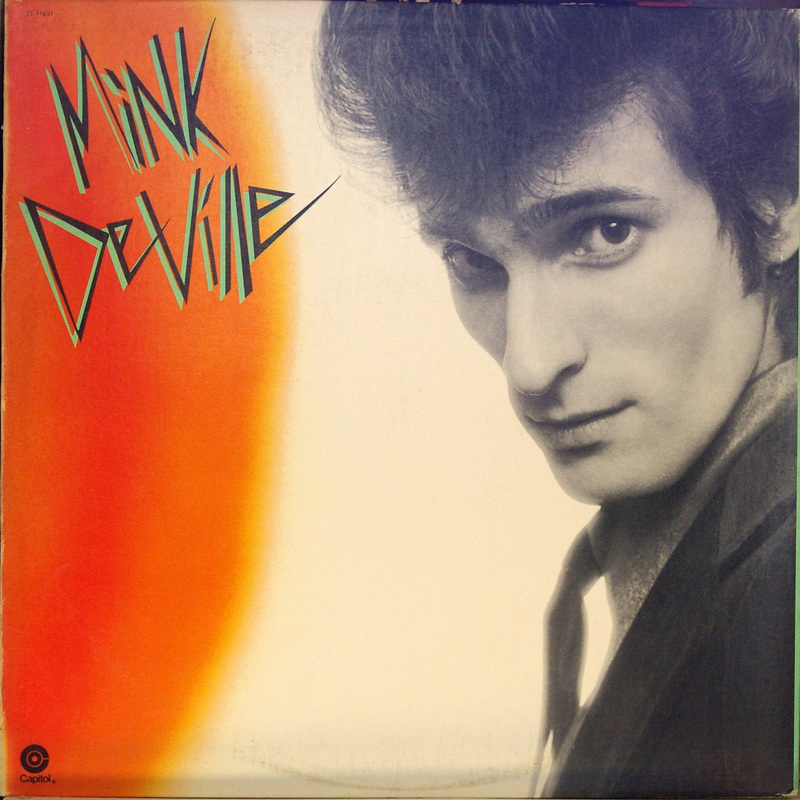
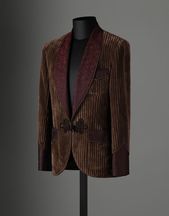
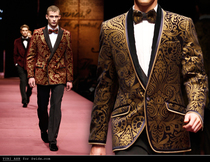
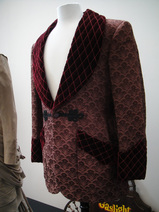
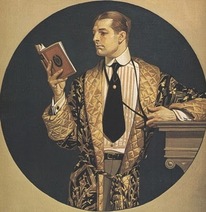
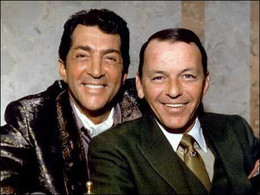
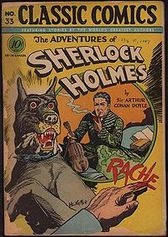
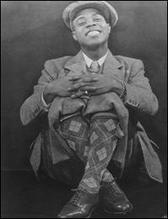

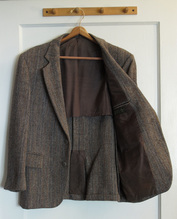

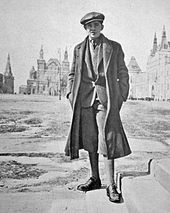
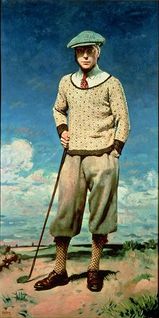
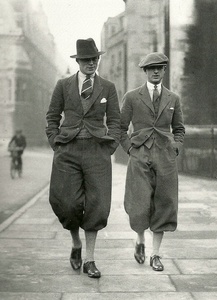
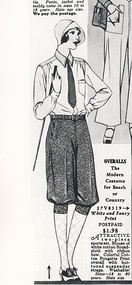

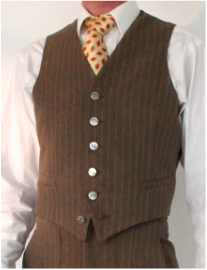
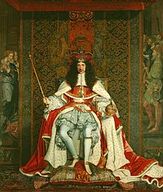
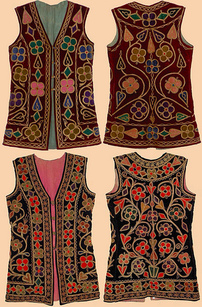
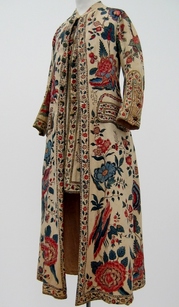
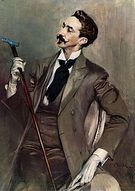
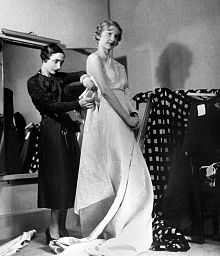
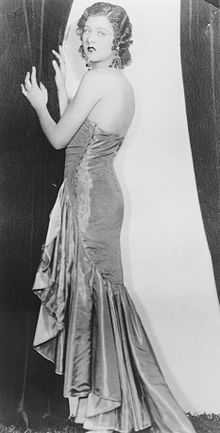
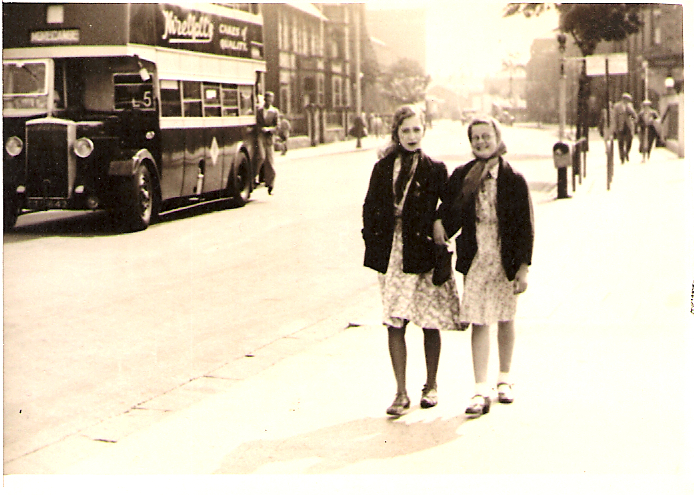
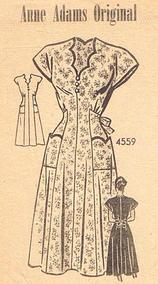
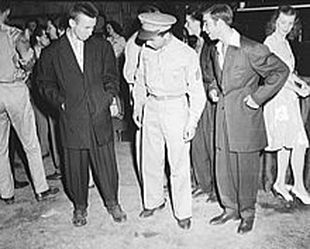
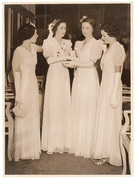
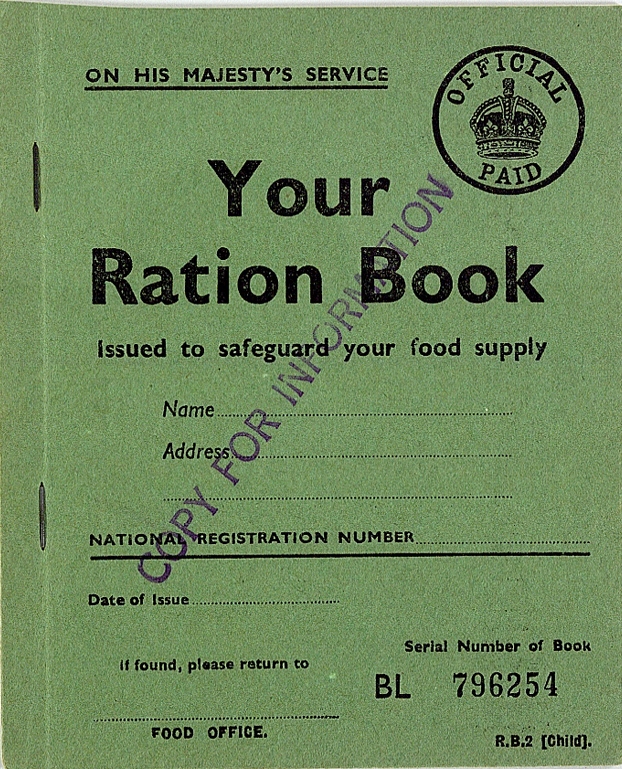
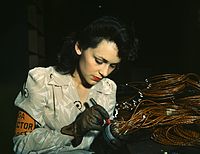
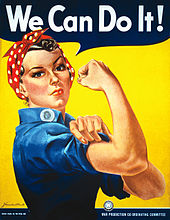
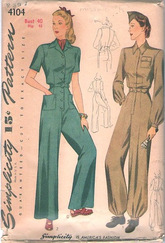
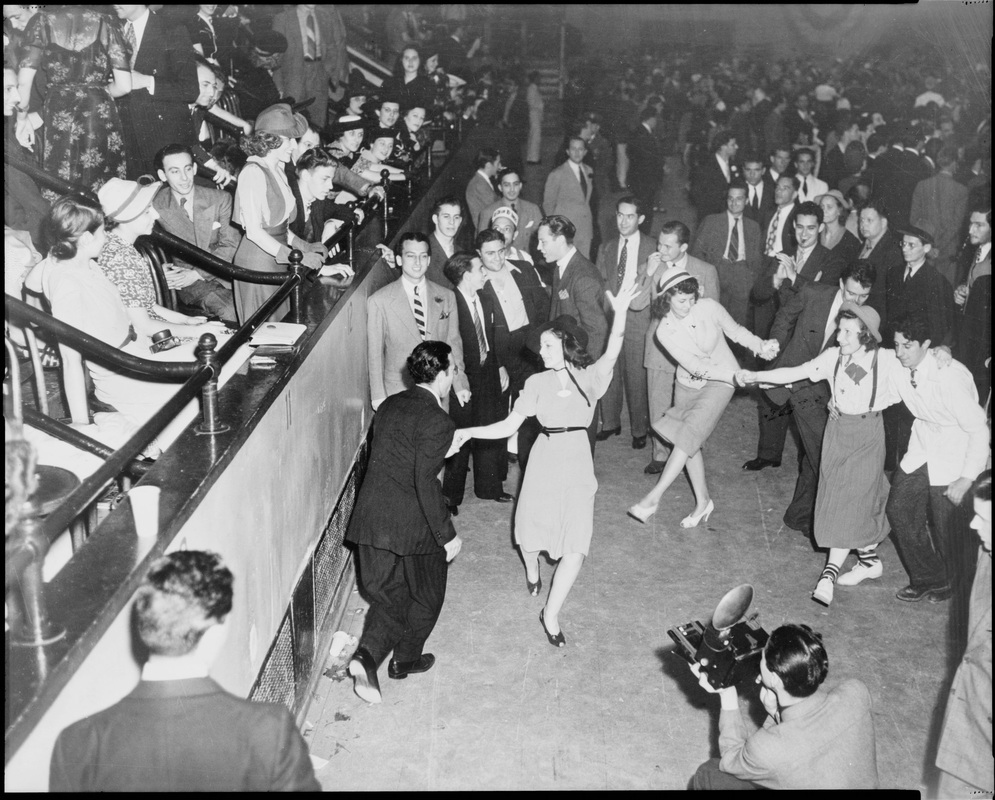
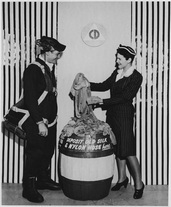
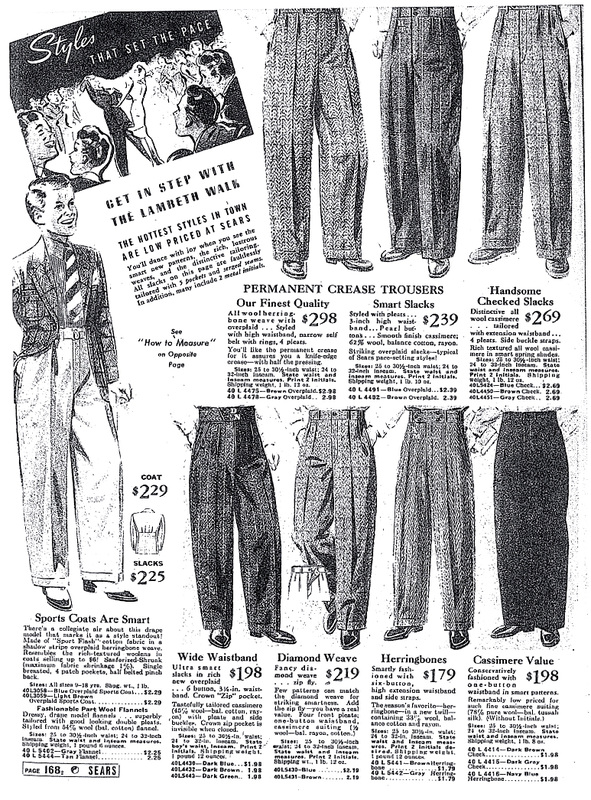
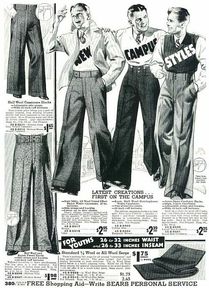
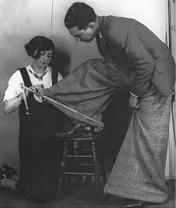
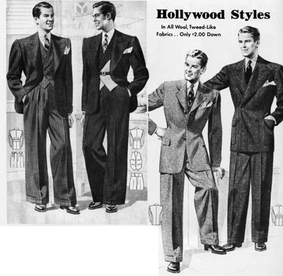

 RSS Feed
RSS Feed
